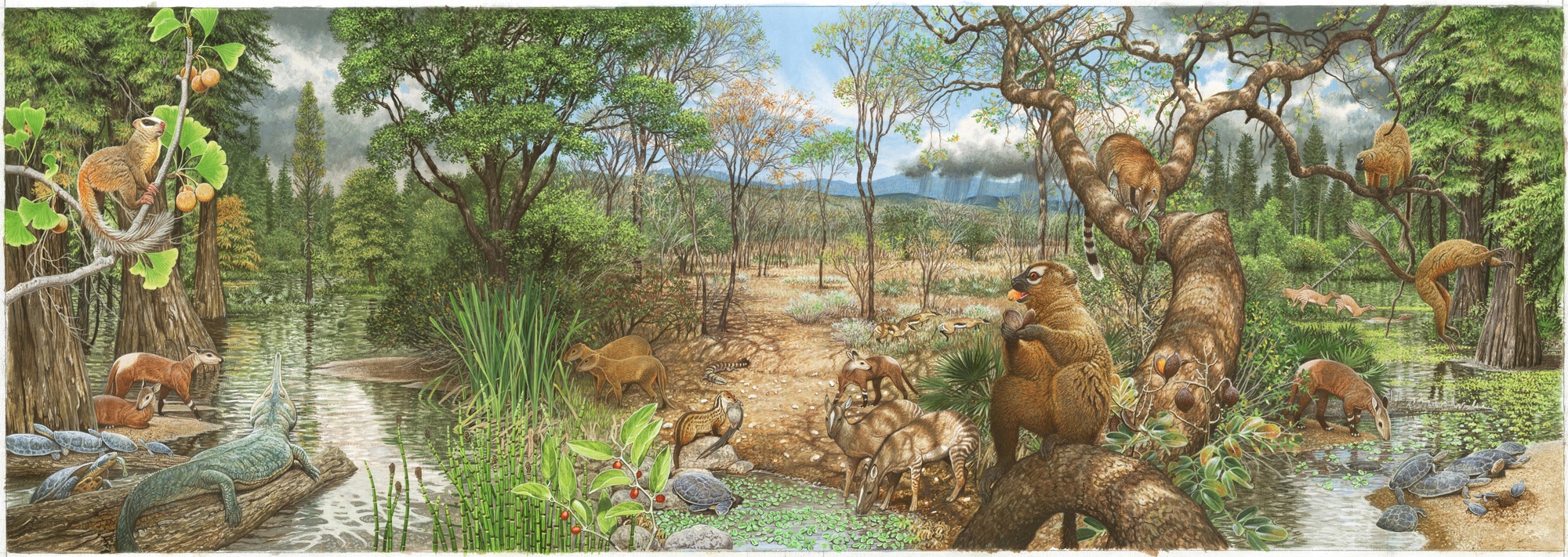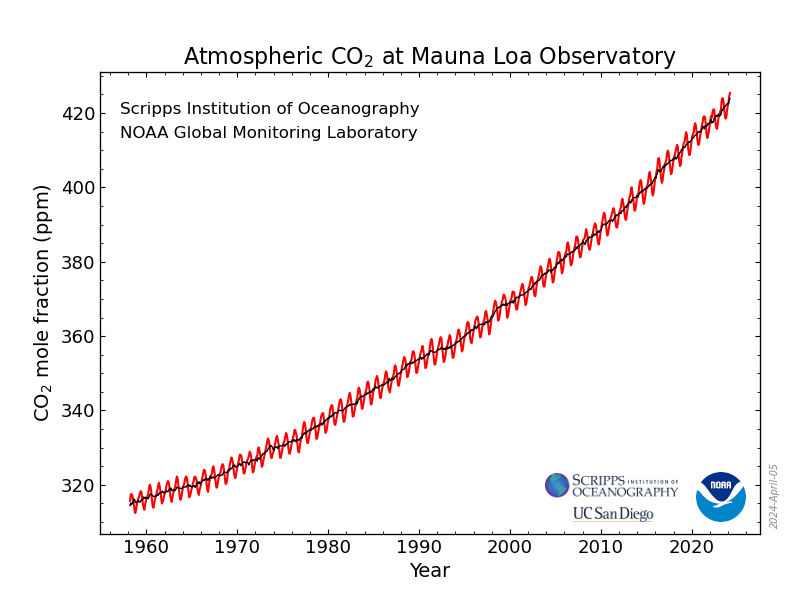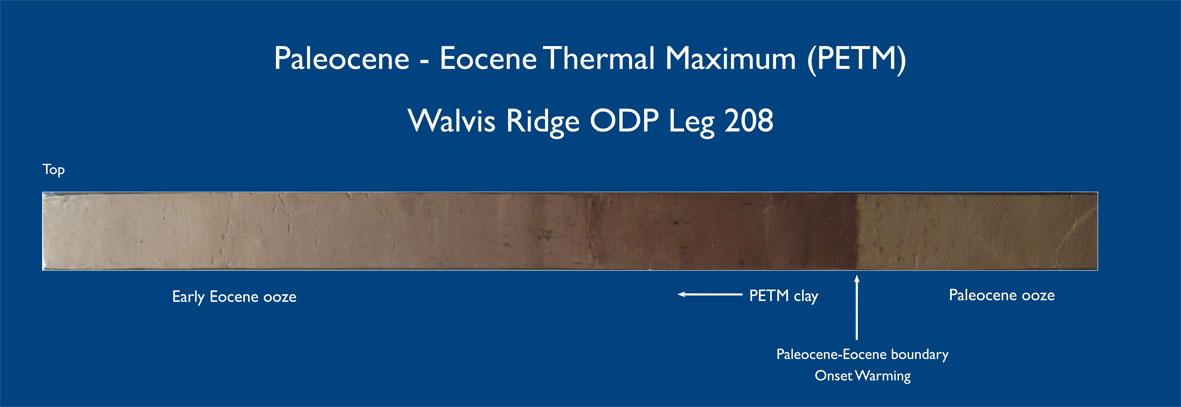


"Over the next few centuries, with unabated emissions of anthropogenic carbon dioxide (CO2), a total of 5000 Pg C may enter the atmosphere, causing CO2 concentrations to rise to approximately 2000 ppmv, global temperature to warm by more than 8°C and surface ocean pH to decline by approximately 0.7 units. A carbon release of this magnitude is unprecedented during the past 56 million years--and the outcome accordingly difficult to predict. In this regard, the geological record may provide foresight to how the Earth system will respond in the future. -- "Long-term legacy of massive carbon input to the Earth System: Anthropocene versus Eocene" (2013) Richard E. Zeebe & James C. Zachos
BIG QUESTION: What do ancient events show about the effect of climate change on the living world?
The Paleocene-Eocene Thermal Maximum (PETM) Discovered
In 1991 paleoceanographers J.P. Kennet & L.D. Stott noticed an unusual trace in the stable isotope record of marine sediment cores from off of Antarctica dated to the end of the Paleocene Epoch (66.0-56.0 Ma) and the Eocene Epoch (56.0-33.9 Ma). These isotope curves, discovered by sampling the skeletons of tiny marine armored amoebas called foraminfera ("forams", for short), indicated two things:
What on Earth was going on? This represented a dramatic environmental shift, but one that hadn't been recognized before. Or had it? Actually, a few years earlier paleoceanographers had observed a mass die off of foram species at this very boundary. And the paleomammalogists had long known that the boundary of the Paleocene and Eocene coincided with the arrival of certain mammal groups into Europe and North America and the loss of some earlier primitive mammal groups.
Inspired by Kennett & Stott's discoveries, a team of scientists examined the Paleocene-Eocene boundary terrestrial isotopic record (looking at mammal teeth and soils), and found the same dramatic short-term shift in environments. What was going on?
Everything pointed to a very rapid period of intense global warming that started and stopped, geologically speaking, almost instantly. The event was given a name: the Paleocene-Eocene Thermal Maximum (or PETM). This event required further study. But before we get to their discoveries we need to deal with the issue of climates and paleoclimates more generally.
Climate is the average weather for a particular region over some time. That region may be as small as a county or as big as the whole planet (global climate). Climate therefore includes weather but also variations in weather over time. Some researchers specify the amount of time represented for the averaging (30 years is a commonly used numbers), but there is no hard and fast rule.
A folksy way of saying this is "Climate is what you expect, weather is what you get." More importantly, weather is what you can actually see happening; climate requires you to take records over time.
What CAUSES climate? There are three major factors:
Climate change is, therefore, changes in the statistics of weather for a particular region over some time. Nothing in this definition requires climate change to be anthropogenic (human made), nor tied into changes in greenhouse gasses, nor be especially about warming per se. (As we will see, however, recent climate change is all three!)
Of concern to human affairs are three main consequences of climate change, which can perturb human affairs directly or via their effects on other parts of global systems. These three consequences of climate change are:
Here is a video of the shifting distribution of global land temperatures relative to a 1951-1980 mean of Northern Hemisphere summer months (June-July-August):
<
(From the Goddard Institute of Space Studies, NASA)
Here is another look: NASA's Goddard Institute for Space Studies (GISS) plot of global average month-by-month temperatures over most of the instrumental record (that is, the period of time when there are thermometers and such to actually take the temperature of the environment; in this case, starting in 1880):
How are climate (and thus climate change) documented? After all, we are talking about averaged phenomena (rainfall, temperature, pressure, etc., etc., etc.) over the surface of the planet and over long periods of time. There are two main forms of observations we make concerning climates and climate systems:
There is more to understanding climates than our current observations and past estimations. If we want to forecast future events (that is, make predictions), we can rely on two major steps:
Climate (the average weather and its variable for a region over time) is the product of a number of factors, most especially:
None of these features are constant over time, and thus the climate of the world has changed: sometimes quite dramatically. Changes can be produced by:
As a result, climates vary over Earth history. On the biggest scale, we see a change between generally hot (greenhouse) conditions with no substantial ice anywhere and generally cold (icehouse) conditions where ice builds up in the mountains and at the poles. The latter can sometimes be shifted further into ice ages, when large glaciers cover much of the continents.
For the geologically recent past, the record of change is much better understood, and we see that climates can shift from one condition to another on a very short period of time. The degree of change of even the geologically recent past can greatly exceed the conditions under which human civilization arose and grew.
The discovery that climates of the past were different than today was one of the first major discoveries of paleontology. Scientists found some strata in temperate regions with tropical animals and plants, and others in the same region with cold-adapted organisms. So they recognized that the environments of the past were often very different than today.
One specific important discovery was the existence of ice ages: intervals of time when great continental glaciers covered vast regions. In the 19th Century Louis Agassiz and colleagues began to amass data to show that many otherwise puzzling features of European and American geology made sense if large sections of those regions were (geologically-speaking) once under vast ice sheets the way Greenland and Antarctica today. Soon afterwards, it was recognized that there wasn't just one "Ice Age" as such, but rather a series of cold and warm periods alternating over the most recent interval of Earth History.
This ice age cyclicity characterizes the Quaternary Period (2.588 Ma to the present). However, the Quaternary ice ages are not the only one: earlier periods of Earth History also experienced their own pulses of ice age cycles.
hat drove the Ice Age cycles, and how did they begin in the first place? Various ideas were proposed in the 19th Century:
The person who worked out those details was Serbian mathematician and scientist Militun Milankovi&cactue;. While in prison (read up about him elsewhere...) he worked out the relative contribution of three different parameters:
The combination of the different parts of the Milankovitch Cycles result in different amounts of sunlight being received in different latitudes at different times of the year. Milanković determined that the primary driver would be the changes of insolation at high northern latitudes (e.g., 65-68°N) in the summer time. This is because this is the best time and place to control the growth of large continental glaciers. There is far more land in the Northern Hemisphere than the Southern. And harsher winters won't make the ice grow any more or less in general. But the summer is a different story. If the summer stays colder, more ice remains from the previous winter. Since ice has high albedo, it reflects more light as visible light, which goes right back into space. This lets the Earth get colder still, so the ice grows from year to year, causing the ice to advance.
In contrast, if the northern summers get warmer, the ice melts back, exposing more dark soil. Dark soil absorbs sunlight and re-radiates it back as thermal energy (heat). More heat melts the ice more, which exposes more dark soil, which warms stuff up more, and so on.
This was an interesting idea, but Milankovitch cycles predicted many more than just four glacials and interglacials. Because of this, Milanković's ideas were ignored until the middle of the 20th Century. At that time, the Albatross Expedition of 1947-1948 found evidence to support this model. This was a Swedish deep-sea drilling project (one of the first such expeditions), which recovered the first good deep-sea cores with microfossils.
They found patterns of the percentage of calcium carbonate, of oxygen and carbon isotopes, and so forth matched worldwide. And were consistent with changes from warm to cold. And matched Milanković's pattern predicting dozens of glacial advances and retreats, with subcycles within those, and the subcycles within those. They also showed that Milankovitch cycles are constantly at work (which they should be), but that there was a marked cooling beginning at the base of the Quaternary.
Ice ages are only one subset of different conditions under which the world operates. Additionally, there are:
Study of the Ice Ages and paleoclimate change were critical in inspiring many lines of scientific research:
There are cases in the fossil and geologic record when there are profound long-term shifts of climate where we can see how changes in the various components of the Earth system had changed:
But the changes in the PETM and the changes in the modern world turn out to be much faster than continental drift or Milankovitch cyclity. How did these happen?
Fossil data is used to approximate some of the climate conditions of the ancient world. There are different aspects of different fossils that make them useful in this context.
For example, many organisms have very narrow habitat preferences: that is, requirements of temperature, salinity, and the like outside of which they cannot live. So for species of known habitat requirement are found at a fossil site, we can infer that the environment at the time of deposition was within those parameters. For example, compare the modern distribution of these three species of foraminifera (armored amoebas). Each species is associated with a different temperature range. If we were to find a fossil site in the Chesapeake with Neogloboquadrina pachyderma, we could infer that the waters of the Chesapeake at that time was frigid; if we found Globigerinoides ruber, then it was tropical at that time. This method works best if these fossils are of species which are still present or their very close relative (so that we can see the life habits of these creatures in the modern world), or are related to aspects of the physiology that are unlikely to have changed over long periods of geologic time.
In particular, some species make excellent paleothermometers. In some cases they can mark only a particular temperature. The foraminferan Neogloboquadrina pachyderma builds shells with a coil to the right at temperatures above 8°C, but to the left below 8°C. Other paleothermometers can give a range of temperatures. It has been found that the percent of leaves in an environment with smooth (also called "entire") margins is very tightly correlated with the mean annual temperature. So if you find enough leaves at a site to compare this ratio statistically, one can estimate the ancient temperature.
Leaves provide an estimate of an additional paleoclimate parameter: the amount of carbon dioxide. Leaves take in carbon dioxide and "exhale" oxygen through tiny openings called stomata. It has been discovered in laboratory studies that the density of stomata decreases with increasing levels of CO2 and increases with decreasing CO2. Furthermore, this can be used to infer temperature as well.
Additionally, stable isotope data can be used in various types of fossils. Because we are all ultimately comprised of what we eat (and breathe), changes in the isotopic composition of the atmosphere and oceans due to changes in temperatures and the like will be reflected in the shells, leaves, bones, and teeth of fossils. Many elements come in slightly different weights (different numbers of neutrons, although the same number of protons and electrons): each of these is an isotope. Some isotopes are radioactive and naturally break down into other elements. But some are stable. (For instance, carbon has three isotopes: the stable 12C [by far the most common] and 13C, and the radioactive 14C.)
Of these, two very important proxies are δ13C and δ18O, which are recorded in such things as the skeletons of organisms (foram tests, corals, clam shells, mammal bones and teeth, etc.), or material in the soil, or other geological matter:
Using various paleoclimate markers, we can estimate the paleoclimatic conditions of any given fossil site. If we have several sites stacked on top of each other, we can reconstruct the changing climate condition of that location. If we reconstruct many different sites at the same slice of time, we can create paleoclimate maps of the ancient world. And by stacking the paleoclimate maps one after another, we can see shifts in global climate pattern.
While the terrestrial record can occasionally be good for this sort of study, the ocean record is much more continuous. There have been a series of national, and international, programs to systematically drill the ocean floor to (among other things) assess changing paleoclimates. These include:
Furthermore, there are many different projects to specifically reconstruct particular moments in Earth's history. Some of these are of interest, since they are possible models for the changes we humans are putting on the environment.
Fossil fuels are, in fact, real fossils. Coal is the body fossil of vast amounts of plants; petroleum and natural gas are "chemical" fossils derived from the decay and distillation of organic material buried and trapped in sedimentary rocks.
In a very real sense, these are "buried sunlight", as the chemical energy in coal, petroleum, and natural gas was originally produced by photosynthesis in ancient photosynthesizers (plants, algae, phytoplankton) driven by solar energy. This energy is stored in either relatively pure carbon (in coal) or some form of hydrocarbon (compounds of hydrogen and carbon).
With the rise of the steam engine (at the end of the 1700s) and the internal combustion engine (in the late 1800s), fossil
fuels have become the primary source of energy for modern industrial society:
To release the energy in fossil fuels, the coal, gasoline, or gas must be burned. Burning of these fossil fuels releases carbon dioxide as a waste product. Unfortunately, carbon dioxide is a potent greenhouse gas, and so the addition of so much CO2 into the atmosphere has produced a marked change in Earth's climate. But this is not the only reason that climate change happens.
Consumption rates of fossil fuels, production rates of concrete, and other industrial processes are used to independently predict the total amount of anthropogenic (human-generated) greenhouse gasses:
Starting in the mid-20th Century, Charles David Keeling began collecting CO2 on Mauna Loa, Hawai'i. These data continue to be collected giving us a continuous record:

(And other institutions are doing the same elsewhere.)
Both theory and data are consistent with the observation of increasing global temperatures since the Industrial Revolution:

Modeling of temperature changes using only natural climate forcings (blue) fail to match observed temperature patterns (black line); in contrast, models that incorporate anthropogenic forcings (pink) show a very good match to observed:
But modern human experience is vastly too short a time to understand the natural variability in climate systems. So there is a vital need for using geological and fossil proxies to see how Earth's climate systems operate under conditions different than the last 6000 years (the age of written records). For example, we find a very different pattern of carbon dioxide when we expand from instrumental readings of the atmosphere and begin to include longer-term records in glacial ice:
There is more to warming that comes from rapidly increasing CO2. There is global warming's "evil twin", ocean acidification (or OA). Carbon dioxide mixes with the shallow seas, increasing the amount of carbonic acid in the water. All sea water is naturally alkalai to some degree, so OA really is more "decrease in ocean alkalinity". Many marine organisms make shells from calcium carbonate, and most use calcium in various metabolic processes. If water acidity rises faster than the animals can adapt, it will kill some, and in many decrease their ability to grow shells, to metabolize nutrients, etc. properly. This can be bad for the species themselves, and can have even broader environmental impact. For instance, some marine phytoplankton require calcium carbonate shells: these phytoplankton are the base of the food chain in many parts of the sea, so if they decline they starve the animals that eat them. Similarly corals form the home to literally millions of species: as coral reefs diminish due to OA, they threaten the species that make these their homes.
Some geologists have started referring to the most recent several decades (or centuries) as the Anthropocene, the human epoch. Essentially this is defined as "that period of time in which human technological activity has become a major influence on Earth systems. Greenhouse gases are just one factor of this: extinctions, habitat transformation, reshaping of streams, capture of the biosphere for agriculture, and many other attributes of the global environment are now directly influenced by humanity. How will this play out into the future? This is where the fossil record has potential: the past may be the key to the present (and future).
After the initial discovery, interest in the PETM became heightened as a possible ancient analog to Anthropocene warming. What was the scale of the event? How much warming did it produce? What caused it? How long did it take? And (perhaps most importantly) what were the effects on the living things at that time?
Dozens of sites--both marine and terrestrial--where the Paleocene-Eocene transition were preserved were studied by different teams. Eventually enough data was available to really constrain the size of the negative CIE. The event seemed to be a shift by about 4.6 parts per thousand (‰). In order to explain a -4.6‰ change in the atmosphere, it would require:
The reason the number of foram shells disappeared at the PETM had to do with ocean acidification. Geochemists calculated that the level of OA required during the initial burst could only be caused by methane clathrates: there simply wouldn't be enough permafrost or trees or exposed marine mud to cause this shift.
At this time, the continental plates between Greenland and Europe were rifting apart, forming the North Atlantic Ocean. So perhaps this rifting destabilized the methane clathrates?
How fast was the release? Initial models suggested that it was much slower than our Anthropocene greenhouse emissions. But new research published in 2014 and 2015 point to two pulses, each no longer than 1.5 kyr long and separated by 2-5.5 kyr. At their peaks, these degassing events were closer to the present values of emissions (about 1 Pg C/yr, as opposed to today's 9.5 Pg C/yr).
Even though the phase of injection of greenhouse gases was at most less than 9000 years, the entire time in which the environment was disrupted was MUCH longer: the CIE lasted for 113 kyr, and then another 83 kyr before temperatures were restored to pre-PETM levels. The reason for this--and the VERY IMPORTANT LESSON for modern times--is that it is easier to emit lots of carbon than for it to be resorbed by natural systems. Plants abosrb carbon dioxide, but unless you do repeated burial of the forest after forest after forest (as in the Carboniferous) there is very limited amount you can store in plant form. The oceans absorb CO2 (resulting in OA), but over time the shallow seas mix with the deeper ocean to store more. Most importantly, the weathering of rocks binds up carbon dioxide which is then transported and buried as sediment. But all these factors--forest growth, ocean mixing, rock weathering--occur on scales of 10s of kyrs. These are over in a geologic blink of an eye, but to the point of view of inhabitants of these times, the environmental changes last forever.
What were the effects of the PETM? Here are some of the major changes:
The PETM is used as a model for modern anthropogenic greenhouse warming because the amount of gases released and the amount of warming called is just about the same. However, there are some differences:
